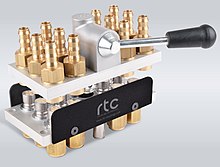Multi-coupling
Multi-couplings and docking systems can connect or disconnect several fluid, pneumatic and / or electrical lines at the same time. The multi-couplings or docking systems are usually in two parts (loose half and fixed half) and consist of carrier plates, media couplings, electrical elements, guide elements and, depending on the design, additional operating and locking elements. If the docking system is to be integrated into a control process of an automated production plant, proximity switches can be used to query the individual coupling steps . The design of the multi-coupling or the docking system depends on the intended use.
Designs
Multi-couplings
Multi-couplings are operated manually, by hand (see also muscle power drive ).
Multi-coupling without actuation aid
The connection or disconnection of the two multi-coupling halves is done exclusively by muscle power. No separate motor / drive part is required.
Multi-coupling with actuation aid
The connection or disconnection and locking or unlocking of the two multi-coupling halves is done by muscle power using a mechanical lever .
Docking systems
Docking systems are operated electrically, pneumatically or hydraulically by means of auxiliary workers.
Power-assisted docking system without delivery unit
To connect or disconnect the two multi-coupling halves, existing movement sequences on site can be used for the coupling process.
Power-assisted docking system with delivery unit
To connect or disconnect the two multi-coupling halves, pneumatic or hydraulic feed units are integrated, if the on-site movement sequences cannot or may not be used.
Quick tool change system for robots
Quick tool change systems for industrial robots are high-precision docking systems for precise and safe tool changes (welding guns, gripping systems, etc.) and consist of a robot-side multi-coupling half, usually several tool-side multi-coupling halves and the corresponding tool racks. General requirements for a change system:
- low dead weight
- low overall height
- modular construction
- self-locking locking
- very good repeatability
- Emergency release device
In addition to the mechanical connection, the elements for information and energy flow are also coupled at the same time. Depending on the area of application, changing systems can be equipped with media couplings (water, hydraulics, air), electrical signal connectors (fiber optic, data bus) and electrical power connectors .
Areas of application and industries
The following list contains only a few examples where multi-couplings and docking systems are used
- Plant construction
- Automobile manufacturing
- automation
- Foundries
- Industrial robots
- Engine construction / engine test bench
- Oil rigs
- Rolling and steel mills
See also
- Couplings for rigid, elastic, movable or detachable connection of two shafts.
literature
- Baier, Herbert; Ricken, Norbert: Quick coupling systems: time-saving connections for fluidic and electrical lines, Landsberg / Lech, Verlag modern industrie AG, 1994, ISBN 3-478-93091-X

